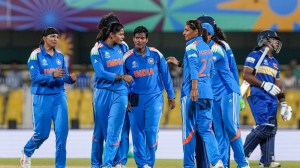Houseful in Cinema Para
Bengali cinema gets back its middle-class audience with urban stories and slick packaging.
Bengali cinema gets back its middle-class audience with urban stories and slick packaging.
At kolkatas Park Street Metro Station,Bengali singer Rupankar is pleading from the television screens Gobheere jao (dig deeper),he urges. A group of tattooed,streaked and sneakered students from the nearby St Xaviers College sways to the beat. The song is a part of an upcoming Bengali film Baishey Srabon and the youngsters watch the trailer with the same kind of interest that they would perhaps reserve for an episode of Glee. There seems to be enough material in the film to hook Kolkatas yuppies. The lead characters are suitably hip,the plot appears interesting,the frames are saturated in moody colours and the songs deal with existential angst,pillow talk and more.
These are the same ingredients that,a year ago,spelt box-office bonanza for another Bengali film,Autograph. The film,by director Srijit Mukherji,was pitched as a tribute to Satyajit Rays landmark work,Nayak,and was made on a budget of Rs 80 lakh. It went on to collect around Rs 5 crore. But econometrician and business analyst Srijit,who left a lucrative job in Bangalore to pursue his destiny in Tollywood,says that his greatest achievement has been to bring the Bengali middle class back into the theatres. The Bengali audience that would treat a Rituparno Ghosh or an Aparna Sen film as an occasional outing and stay away from halls for the rest of the year,has now warmed up to medium-budget films that tell a good story well. There is no reason why we should demarcate films as sensitive or commercial. In the 50s and 60s directors like Tapan Sinha,Ajay Kar and Asit Sen would make commercially successful and sensitive films. The trick is to tell a good story with conviction, says Srijit,who roped in Bangla film superstar Prosenjit for Autograph,his first film.
After the long queues for tickets in the 50s and 60s,Bengali cinema went into a 40-year-long slump and it was tough to figure out what the audiences wanted. Over-the-top productions and histrionics ruled the screen. Even five years ago,nobody could have imagined a packed house for a mainstream Bengali film. Which is why,the Houseful sign at north Kolkatas Star Theatre,in an area known as Cinema Para,is a pointer to changing times,especially since it is a weekday afternoon. The film playing inside is Shiboprasad Mukherjee and Nandita Roys Ichche,a tale of a possessive mother and her troubled relationship with her son. Ichche is one of those films,which did not have to depend on the PR machinery to draw in crowds. It was made with a budget of Rs 45 lakh and has crossed the Rs 1 crore mark in its seventh week, says Shiboprasad. The well-packaged film has hit home with the Bengali middle-class. Bengali mothers are known to be exceptionally protective. The audience probably identified with the theme, he adds.
There was a generation of Bengali cinema,which talked about small towns and villages. Today,we want to talk about our cities and the way people live in them. Whats wrong with that? asks Srijit. Playing in a hall near him is Kamaleshwar Mukherjees recent film Uro Chithi which is fast becoming a must-watch among the young crowd. My film is about 12 text messages and how they affect 12 lives in a city like Kolkata. Its a very urban film,with people who could be inhabitants of any other modern city of the world, says Kamaleshwar.
According to director Suman Mukhopadhyay,the resurgence of Bengali films owes a lot to the success of Bollywood films such as Love Sex aur Dhokha. There has been a ripple effect, he says,The success of films like LSD has encouraged producers to experiment with subjects and styles in Bengali films too. Even as filmmakers experimented with films,viewers seemed to be doing the same. Mukhopadhyays own film,Mahanagar@Kolkata,shows him waiting patiently in the aisle of a rambling,rusty city hospital as his protagonist,Kolkata,bares her fangs in a grimy game of underworld rivalry,set against the reassuring darkness of a rain-soaked night. Or,sneaks into the posh,luxurious bedroom of an affluent south Kolkata Bengali couple bickering over their choices in life. The filmmaker explores the delicate layers of urban Bengali consciousness from the airy,social exchanges of the rich to the obsessions of the lower middle class even as he shows how the city invades the subconsciousness of its people.
Mukhopadhyay debuted in the Bengali film world of 2006 with a deeply unsettling story of a man who thought he could talk to the dead,and followed it up with Chaturanga,his provocative interpretation of a Tagore classic. His subjects,derived from canonical to contemporary Bengali literature,have always reflected his active engagement with social and contemporary political realities of Bengal and specifically Kolkata.
The trend of such films started a couple of years ago with Anjan Dutts Bong Connection,Birsa Dasguptas 033 and Aniruddha Ray Chaudhurys Antaheen. Some films,like Bong Connection and Antaheen succeeded while others like 033 sank. But the stage was set. In a way,they softened the blow for us, says Srijit. As did films like Gaurav Pandeys Shukhno Lanka, a heartwarming tale of a Tollywood extra. Its not really that hard to understand the Bengali middle-class audience,or for that matter any audience. They want to watch films with a soul,told simply. Thats why Satyajit Rays Feluda films and Goopi-Bagha films were such big hits, says Pandey.
In 2009,Parambrata Chatterjee started shooting for his directorial debut film,an urban comedy Jiyo Kaka. It released earlier this year. Chatterjee spent 2010 studying abroad. When I came back,I realised that the approach to Bengali filmmaking had changed quite extensively. I cant point out the specific markers,but they were being shot differently,they were packaged smartly and they had also found a new interested audience, says Chatterjee. Today,world cinema is a click of the TV remote away. So,an informed middle class is exposed to a plethora of films from across the world. Along with education and affluence,comes a sense of pride in your own culture, says Chatterjee.
He adds that the new generation of filmmakers and audience have to reach out to each other to ensure that Bengali films regain the universal appeal of the golden era when films did not focus on a specific social or economic group. Starting with technical basics like camera work and tight dialogue writing might help, feels Srijit. We have already started to bridge that gap slowly in technical terms. Anupam Roy,who has done the music for my film,has also scored the music for a potboiler,Chalo Paltai, he adds.
As a genre of polished films unleash their magic,what about the loud Tollywood staples? Is it the end of the road for Swapan Saha-Haranath Chakrabortys school of potboilers? Not really. Chakraborty has delivered more than a dozen hits in the past two decades,in his over-the-top and garish style.
His latest,Chalo Paltai has thundering dialogues,melodrama and comedy,but it also tells the story differently. The cinematography is slick,as is the use of music (restricted to background scores instead of lip-synced song-and-dance numbers). Even if we use all the tropes of commercial cinema,we should present it in a stylish manner. Why do you think Dabangg worked? Because it didnt undermine its audience. We have been doing that for far too long, says Srijit.



- 01
- 02
- 03
- 04
- 05



























